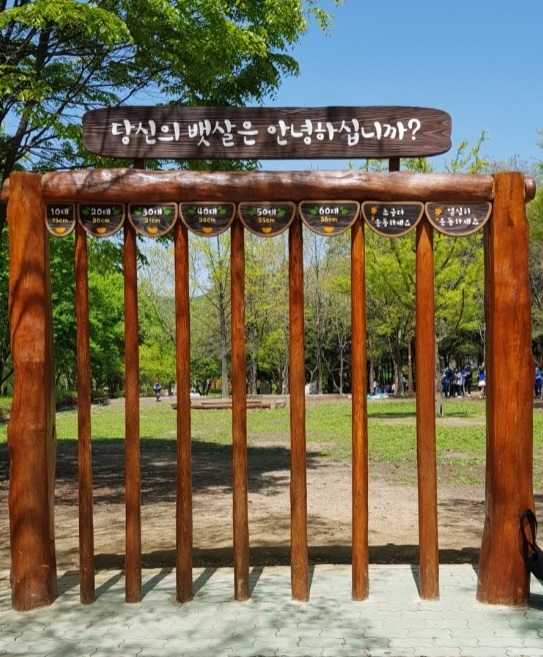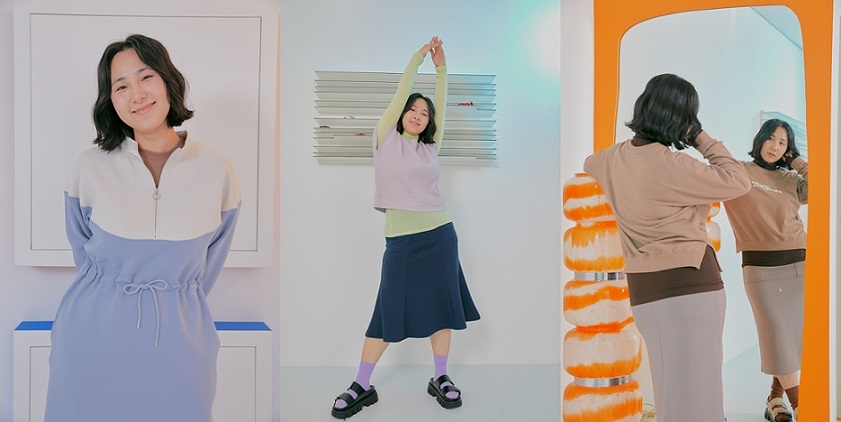 |
A wooden square frame placed at the Incheon Grand Park with a sign saying “how is your belly doing.” (Kim He-wha.) |
When Diana Nordeus encountered a large wooden frame installed at a highway rest area in Hongcheon, Gangwon Province, last September with a supposedly cute sign saying, “How’s your belly doing?” she couldn’t just laugh it off.
To her, it seemed like yet another blatant display of Korean society’s obsession with thinness, with which she has had some first-hand experience.
“I was very malnourished when I first came to Korea in May last year and the owner of my house here saw me at that point. I later moved out but came back to visit a few months later and the first thing he said to me was that I looked fat and gained weight,” said Nordeus, an exchange student from the United States currently residing in Seoul.
“I only put on a few pounds and was satisfied with my body. But once he said that, I felt horrible about myself.”
The structure in question resembles a prison door with vertical bars. The bars are placed at a precise spacing to make the gap match an ideal waist width by age group: 17.35 centimeters for people in their 20s, 19.2 centimeters for those in 30s, 20.32 centimeters for those in 40s, 22.77 centimeters for those in 50s and 24.99 centimeters for those in 60s.
Nordeus failed to pass through the bars for those in their 30s, let alone the ones for her age group.
 |
Diana Nordeus, a 20-year-old American college student in Seoul, tries to fit through the bars of a wooden installation at a highway rest area in Hongcheon, Gangwon Province, that shows the ideal waist widths for different age groups, in September 2021. (Diana Nordeus) |
It sure has good intentions -- to encourage people to exercise, but “the narrow bars represent body images shown in the media that a lot of Korean women are striving for,” she said.
Nordeus is apparently not alone. On TikTok, there are plenty of videos under hashtags like “Koreanbeautystandard,” with users showing off similar structures.
A search for “your belly” on portal site Naver returns a plethora of images of the structures placed at various parks and popular tourist sites, including one at Daeboo Island in Ansan, Gyeonggi Province. Some apparently have different phrases like “What’s your belly fat age?” and “Does your belly size meet the standard?”
Maggie, a 31-year-old Canadian teaching English at a language academy in Incheon, has also seen several in nearby parks.
“The ideal size of waist width set by the installations reminded me of K-pop idols, actors and online influencers here with Barbie doll-like figure, making me have a stereotype of Korea’s beauty standards.”
Stay healthy, and thin
It was Seoul’s Yangcheon District that first came up with the public installation in 2016.
“It was to motivate residents to improve their physical strength through exercise,” an official at the district office told The Korea Herald.
“We constructed the instruments in major parks, including Yangcheon Park and Gyenam Park. Then, other district offices across the nation started to follow suit.”
The ideal waist sizes, as suggested by the spacing of bars, are based on official data, the official touted.
The data is from the average body sizes of Koreans aged 16-69, announced by the state-run Korean Agency for Technology and Standards in 2015. The standard setting agency has released the average heights, sitting heights, chest sizes, weights and waist lines of Koreans once every five to seven years since 1979. The 2015 data was the most recent at the time Yangcheon District made the installation.
To be fair, Koreans have smaller frames in general compared to people in many Western countries. But it is also undeniable that Korea as a society forces certain body images upon people – particularly on young women, observers say.
In a typical example, local media glamorizes the unrealistic bodies of TV celebrities, as seen in a flood of online news covering their weight gains and losses.
Additionally, many K-pop girl groups generally conform to an ideal body type of being super thin and slim, with very few exceptions. It’s common to see young starlets share testimonials of extreme dieting on television, which may jeopardize their health in the long run.
This obsession with being thin has even given rise to what’s called the “50kg myth” among young people – a belief that a woman weighing over 50 kilograms (110 pounds) is chubby in Korea, regardless of their height, as girl group members often talk about breaching the 50kg bar as if it is something unimaginable.
“Even ordinary women on Korea’s reality dating shows starring non-celebrities all have a thin waist, skinny legs and arms, making me think that a stick-thin figure is definitely touted as presentable and even an admirable aspect in Korea,” Maggie, the English teacher, said.
Body positivity pushes back
There are young Korean women who defy the society’s unrealistic body standards in an effort to embrace their natural figures.
Known as the “body positivity” movement, its practitioners encourage people to celebrate their body types and sizes that do not fit society’s strict beauty standards.
Calling themselves “natural-sized,” some create lookbook videos or posts wearing large or plus size clothes on social media platforms and YouTube.
Some local fashion companies have also rolled up their sleeves to spread positive body images.
Under the slogan of “Shake the frame, Every, Body,” E-Land Group’s fast fashion brand SPAO replaced its mannequins last October with new ones that resemble the average weight of Korean men and women at some of its stores. Both the natural-size male and female models have a nearly 30-inch waist, gaining 2.3 inches and 5.9 inches from their previous iterations.
At the forefront of the body positivity movement is Park I-seul, the nation’s first body positive influencer and a self-proclaimed natural-size model.
She said body positivity is often misunderstood to be neglecting the importance of weight loss and exercise for physical health.
 |
Park I-seul, 27, Korea‘s first body positive influencer, calls herself a ”natural-size model.” (Park I-seul) |
“Some people say to me, ‘don’t rationalize obesity and laziness under the name of body positivity.’ I’m not trying to spread messages like ‘There’s no need to exercise’ or ‘It’s okay to get fat,’” Park said in a phone interview.
The message she is trying to send is that people deserve to be confident and happy, even if their figure is far from tough social standards.
“Sometimes, even if you don’t want to, your body changes due to unexpected illness or emotional stress. For example, you may find it difficult to lose weight when you are suffering from diseases like polycystic ovarian syndrome, whose symptoms include weight gain. The courage to accept my body (as it is) is what the body positivity is all about.”
By Choi Jae-hee (
cjh@heraldcorp.com)





![[Today’s K-pop] Blackpink’s Jennie, Lisa invited to Coachella as solo acts](http://res.heraldm.com/phpwas/restmb_idxmake.php?idx=644&simg=/content/image/2024/11/21/20241121050099_0.jpg)




